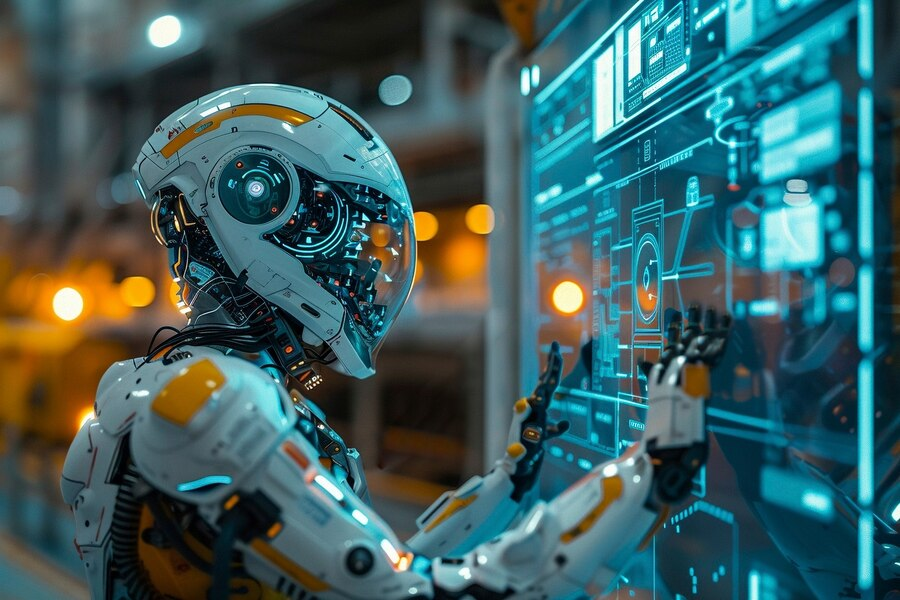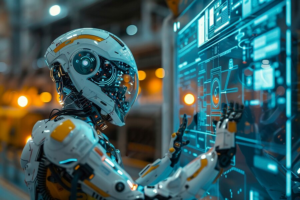During the era of modern industrialization, robots and automation started to be used together in a new age called Industry 4.0. This change recognises not only the incorporation of advanced technologies into manufacturing, but also a cultural transition in how things are manufactured globally. At the core of Industry 4.0, robotics and automation systems are enabling fresh heights of efficiency, safety and innovation in a range societies across various sectors.
Summary of Industry 4.0
Industry 4.0, sometimes known as the Fourth Industrial Revolution, follows in the footsteps of the previous industrial revolutions but focuses substantially on connection, control, and data interchange. At its heart, it is centered around cyber-physical systems, the Internet, and cloud computing, as well as artificial intelligence, which brings intelligence to developing a self-operating factory.
This will introduce you to the different types of industrial robots used in Industry 4.0 (i.e., more traditional, rigid dual-armed and single-arm assembly line workers), collaborative robots or “cobots” for human/robot interaction assistants working side-by-side with humans on an assembly line collaboratively as opposed to solitary mobile warehouse order pickerers….
Application-based Robotics: Take a look at industry-specific applications of the robotic in automotive manufacturing, electronics assembly, pharmaceutical production and food processing.
AutomationAutomated systems filter through processes in the production line, reducing human intervention and decreasing errors. This is not just the case of robotic assembly lines through to automated inventory management and even predictive maintainance.
Automated Manufacturing Processes: Explain how automation streamlines manufacturing operations, boosts process efficiency and cuts production costs.
IoT & AI Driven: Discuss how automation systems integrate IoT data (when applicable) with advanced AI algorithms for real-time decision-making, predictive maintenance and model-based adaptive manufacturing processes.
Internet of Things (IoT) devices that build a real-time methodology to monitor and control the machinery as well as processes, empowering them in data-driven decision-making leading towards operational optimisation.
Section: IoT in Manufacturing (Discuss some of the following) For what types of asset tracking scenarios Do predictive maintenance Use IIoT for energy management How should quality control IIot applications be designed
Its many classes will offer a deep dive in how IoT sensors collect device data and use data analytics to unlock insights needed for operational efficiency.
Artificial Intelligence (AI): By analyzing large volumes of data with AI machine learning models and predictive analytics, algorithms are able to optimize production schedules predict maintenance needs or enhance product quality.
AI in Robotics: Get introduced the robot of tomorrow, machine vision to quality inspection and maintenance predictive optimization as well as self-caring robotic systems powered by AI.
Machine Learning Algorithms: We explore how machine learning techniques such as adaptive learning in robotic task and AI-driven optimization of manufacturing processes influence robotics & automation.
Industry 4.0 Robotics
Robotics is changing manufacturing and industrial processes with respect to Industry 4.0;
Improved Efficiency and Productivity
Robots are as precise as can be and always accurate, resulting in the near perfect task-execution leading to minimum mistake at manufacturing level. This kind of precision is necessary in industries from electronics manufacturing to automotive assembly and pharmaceutical production.
Speed & Scalability: Robot powered automation systems work at a rapid pace leading to good production output and scalability higher than human labor.Being able to do this is important, especially as how quickly a product arrives on the market can be one of its selling points.
Continuous operation: Robots, being machines and not humans, do not get tired so they can work all day long without a break where as human workers need shorter hours of working since fatigue kosts In this way resources are used more effectively.
Success stories (Case Studies): Give examples of companies which have implemented the robotic systems and yield success such as efficiency, productivity improvement to save big amount cost.
Safety and Risk Mitigation
Hazardous Jobs – Robots safely handle dangerous materials and some robots work with potentially unsafe workflows like welding or handling toxic substances which means less human exposure to hazardous working environments leading to enhanced safety.
Ergonomic advantages: Collaborative robots (cobots) are created to work securely close by individuals. They help scale repetitive work, lifting heavy payloads of up often ergonomically challenging operations that reduce the possibility of workplace injuries and musculoskeletal disorders.
Safety Process: Cover safety process and standards related to the robotic domain (risk assessment, safety sensor, collaborative robot design principle…)
Flexibility and Adaptability
Agility: At the basis, robotic platforms can succumbed to different types of tasks and production scenarios through programming. This flexibility enables manufacturers to more quickly reconfigure production lines in response to changes in consumer demands or operational needs.
Customization As robotics and automation technologies advance further, mass customization may become economically feasible. Various intricate tasks and operations may be performed by robots for personalized manufacturing procedures, making it possible to satisfy individual market demands without sacrificing the overall efficiency of the procedures.
Agile manufacturing
Robotics-enabled agile manufacturing allows companies to react fast to market fluctuations and customize their product by reducing the lead time for completion. Industry 4.0 Automation: Production Processes Automation Automation is used in a variety of industrial fields to optimize and enhance production procedures while remaining focusing on market needs and trends. Some of its most important applications are:
Supply chain
Automated warehousing: “AGVs or a robot arm can do the heavy lifting needed in a warehouse, from inventory to order-picking and goods conveyance, substantially reducing lead time and making the supply chain more efficient”.
Predictive Inventory Management: IoT sensors on inventory can automatically notify businesses when their items are scrapping the bottom of stock or approaching an overstock.
Warehouse Automation: Discuss the Latest Trends in Warehouse Automation Technology like Robotic Picking Systems, Automated palletizing etc.
Manufacturing Operations
Smart Manufacturing (ie: real-time data from connected machinery or IoT sensors on equipment performance to detect problems early and improve product quality) The data is analyzed by AI algorithms to enhance production schedules, prevent equipment breaks and maintain the desired product standards.
Digital Twins: Manufacturers use digital twins, or virtual models of physical assets and processes, to simulate production workflows; predict maintenance requirements; etc.
Applications in Digital Twins: To give examples of how digital twins can be applied to manufacturing, like predictive maintenance and process optimization for manufacturers; as well as virtual commissioning of production lines.
Quality Assurance and Testing
The AI algorithms and vision systems for automated quality inspection of parts : to detect deviations from specifications or defects, in a highly accurate way. The ability to operate without human interference allows the quality of products in production to be improved, thus reducing waste.
Quality Control Review: Explore strategies to incorporate automated inspection systems into quality management processes with the objective of meeting (and exceeding) regulatory standards as well fulfilling customer expectations
Maintenance and Servicing
Predictive Maintenance (IoT Sensors and AI-driven Analytics that collect real-time performance data to keep contracting before they break it) It reduces downtimes, leads to the life expectancy of equipment and decreases your operational costs.
Predictive Maintenance Best Practices, led by methods around avoiding failures through condition monitoring, outlier detection and predictive analytics for performance optimization of your equipment.
Challenges in Implementing Robotics & Automation
Although the advantages of robotics and automation are tremendous in Industry 4.0, there can be a multitude of issues that you may face during integration like:
Adjusting Your Workforce | Training
Skills Gap – Shifting to automated factory areas will require purchasing skills or even training workers on how systems based robotics and AI may operate, become managed, and be maintained.
Training Programs: Emphasize the value of educational training programs and lifelong learning opportunities for employees, such as robotics application experience along with automation skills certifications.
Human-Robot Collaboration
Workspace collaboration: Enabling or, for that matter creating an effective workspace where humans can collaborate safely and work collaboratively with cobots are necessary; simply put is working on having the people be trained to interact well and at the same time maximize their human input strength strategically in relief of automation capabilities.
Safety: Inform on safety standards and directives in the area of collaborative robots, focusing on issues such as risk assessment methods or requirements for safe human-robot collaboration process or instances where ergonomic aspects are to be considered within robot design.
Protection of Data and Changes in Cyber And Information Security
Privacy of data: Here security comes with a greater responsibility as IoT devices and interconnected systems generate huge sets of sensitive information. You need to take security seriously as relevant cyber threats make your data more prone to unauthorized use.
Provide guidance on cybersecurity best practices. Guidelines should include network segmentation, encryption, access control, regular vulnerability assessment, and other practices. Encouraging robot and automation manufacturers to ensure that their products comply with these practices is the most effective way of enabling the practices.
Job Displacement: This is a critical yet obvious implication where jobs will be lost through automation. Proactive workforce planning, education policies, and policies that support job creation in emerging fields will help address concerns.
Combatting Bias and Discrimination: If AI algorithms are responsible for many of the decision-making tasks conducted by robotics, they need to follow universally accepted ethical guidelines in addition to transparency and accountability requirements that prevent bias, discrimination or unintended consequences.
Autonomous Decision-Making, Learning in Dynamic Controller Uses AI to Drive
Robotics Performance : The controller uses AI-driven autonomy for deciding how fast a robot arm should repeat an action and adapt task sequence.
Applications of machine learning: Investigate how to leverage the advantages of machine learning in robotics, which can include predictive maintenance and adaptive control systems as well as AI-driven production process optimization.
Collaborative robotics (or Cobotics), Human-centric Design,
Increased Safety Features: With new sensor technologies and AI-based safety measures, the human-robot collaboration environment is now safer than before leading to trustworthiness in shared work spaces.
User focused design – Importance of user centric design principles in developing robotics interfaces and ergonomic solutions to increase usability & acceptance(utils)
Eco-friendly Design Practices
Energy efficient: More robots and automation systems are now being designed for reduced energy consumption, helping to lower the industrial carbon footprint and instigating sustainable manufacturing.
Circular Economy Initiatives: Automation supports circular economy objectives like waste minimization, resource conservation and value chain optimization.
Country Franchising and Its Global Acceptance The 4.0%-world
Global Partnerships and Knowledge Sharing: International collaboration is imperative among nations to adopt Industry 4.0 technologies more rapidly, driving innovation in a range of sectors and facilitating economic growth around the world across numerous industries.
SMEs and Digital Transformation: with a combination of end-to-end solutions, task-specific services providers across the value chain & open collaboration platforms how robotics & automation could become availiable to SMEs in similar fashion as machinery was available so far and spark wider economic development.
Conclusion
Robotic and automation has been the cornerstone of Industry 4.0 evolution, drastically changing manufacturing & industrial operations globally Advanced technologies such as robotics, AI and IoT can play a vital role in streamlining processes within organizations by working towards efficient operations drive safety, sustainability that also acts as an ingredient for innovation across multiple borders of business direction.
Worker readiness, cyber-security and ethical concerns will pose significant challenges as automation becomes widespread across industries. Resource Location Proactive strategies, such as to actively invest in skill building and training opportunities (including reskilling), robust cyber security standards and competent AI governance frameworks that guarantee responsible proof of value whilst maximizing the societal gains through Industry 4.0 technologiesandeducation.encourages Strategies aimed at fostering greater availability Terms & Conditions ForFor editorial content.Content targeted for described editors with links.
Advancing into the future, we see further advancements through innovation, collaboration and regulatory alignment that empower a bright new era of robotics and automation where intelligent connected manufacturing communities enable productivity increases for workers to create stable economic development.

